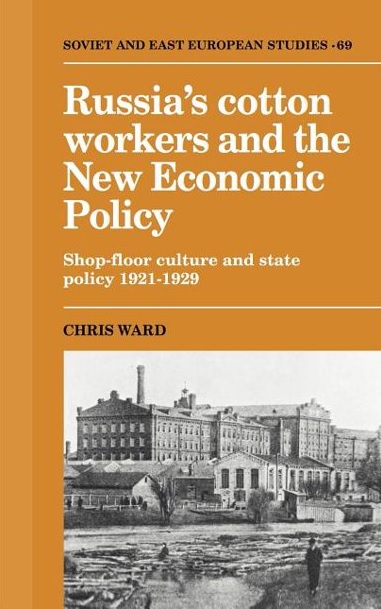Chris Ward. Russia’s Cotton Workers and the New Economic Policy. Shop-floor culture and state policy, 1921-1929.
Cambridge: Cambridge University Press, 1990.
330 páginas.
Contents
Maps
Introduction
PART I
THE NEW ECONOMIC POLICY AND COTTON
1 – Industry
The development of the cotton industry
Decline and recovery
Organization
2 – Workforce
Numbers and location
New and established operatives
Social characteristics
PART II
THE MILL
3 – Field and factory
The problem of Tie with the land’
Tie with the land and wage dependence
Residence patterns and time dependence
4 – Machines and trades
The technological context
Initial processing romos
Preparatory departments
Fine spinning halls
Weaving sheds
5 – Making an operative
Recruitment
Training
The shop floor
6 – Workers’ institutional commitments
The party
The unión
Religion
PART III
THE CRISIS OF 1923 AND ITS CONSEQUENCES
7 – The market collapses
The market
The problem of unemployment
The meaning of unemployment
8 – Organizing Taylorism: production
The origins of NOT
ISNOT and the problems of rationalization
The beginnings of the uplotnenie drive
9 – Organizing Taylorism: wages
Wage levels and wage scales
Wage bargaining and conflicto
The problem of rationalizing wages
Imposing individual piece rates
10 – 1925
The strike movement
Uplotnenie, shop-floor democracy and wages
The social and technological context
The implications of 1925
PART IV
THE CRISIS OF 1927 AND ITS CONSEQUENCES
11 – Confusion worse confounded
The war scare
The seven-hour day
Finding new operatives
Implementing the seven-hour day
12 – Shop-floor responses
A new institution and the new handbook
Implementation on the shop floor
The shop floor absorbs change
13 – The end of rationality
Taking stock
Enthusiasm and mobilization
The end of NEP in the mills
Conclusion
Appendix
Bibliography
